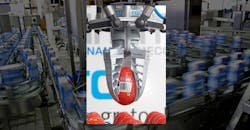Packaging Gymnastics: Manufacturers Need Speed and Flexibility to Invest
As machine builders look to create the next generation of packaging equipment, manufacturing have four simple requests:
Make it flexible. Make it faster. Make it more efficient. And make sure it is automated.
Those were some of the findings in PMMI’s “2019 Flexible Packaging Assessment Report”, presented at the recent Pack Expo in Las Vegas. The full report is available on the PMMI website under its “Business Intelligence” tab.
As manufacturers work to meet the consumer demand for customized products and retailers look to improve margins in a tightening marketplace, the report states that an opportunity exists for machine builders to help deliver on those goals.
“Manufacturers are looking for packaging equipment that provides high functionality and productivity,” the report stated. “Flexible, fast, automated equipment that promotes sustainability is in demand. Machinery that helps companies be more agile to respond to consumer demands while reducing energy and labor costs is more apt to be considered when new machinery is being evaluated.”
But if such equipment is developed, there is an appetite by manufacturers in this space to expand or upgrade their equipment. The report found that 42% of manufacturers are changing from mass production to mass customization, requiring a far more flexible machine. “This production style requires machines and systems capable of quick changeovers to reduce the downtime required to prepare machines for the next product or packaging to be run on the line,” the report states. “Manufacturers claim that it is almost imperative that the machine changeovers are almost instantaneous.”
Manufacturers also want to double the speed of flexible packaging machines from the current 180 pouches per minute to up to 400 per minute. While the speed increases, they also want to use less energy, as the report notes that about 12% of total production costs are energy-related. The packagers also are environmentally conscious and expect new equipment to reduce not just overall energy spend, but to make more efficient use of all materials.
With the continued pressure on hiring for manufacturing jobs, manufacturers are turning to automated systems, and the packaging industry is among its leading proponents. The report cites automatic bagging systems and robotic case packing as two areas that can be both effectively automated and can relieve humans from ergonomic and repetitive motion injury issues.
The tipping point for manufacturers on equipment investment will be finding how much cost savings can be found in new equipment investment. If they cannot find it within their organization, they may look elsewhere. “If new machines do not improve production operations by at least 20-25%,” the report noted, “nearly 50% of companies stated that they would go to a contract manufacturer before making an investment to bring equipment in-house.”
The vice president of engineering for a food company is quoted in the report as adding, “To get us to invest in new machines, we would need the machines to be more flexible and easier to change over. For instance, not having to turn off the equipment to make a film change and allowing us to change it and splice it in would be a huge time saver. That right there would make us consider buying new equipment.”
“If they built machines that let us run all types of flexible materials with a reduction of scrap, then we would consider buying new machines,” said a food company product engineer in the report. “Right now, in order to accommodate different material types, the machines have a wide tolerance range, so you get a lot of scrap. If they could reduce the scrap to around 2% or less, we would be more likely to invest in new machines.”
While technology itself is a challenge for the packaging industry and for the companies that develop the next generation of equipment, there are other areas of concern. Tariffs, particularly the 25% steel tariff, has put a great deal of price pressure on printing presses and converting machinery, according to the report.
This contributes to greater pressure on overall costs, and a smaller appetite for investment, according to the report. “Despite the lower relative cost of flexible packaging, 34% of interviewed manufacturers are resisting switching over because their current packaging machinery is in place and expensive to replace,” it states. “Furthermore, some of the common raw materials used in flexible packaging includes paper, plastic, resins, films, paperboard, and adhesives, which have experienced steep price increases recently.”
But another challenge is packaging products when consumers aren’t influenced by the packaging. “The growth of online shopping is often perceived as a challenge because it reduces the emotional impact to buy that packaging generates in retail stores,” the report adds. “Manufacturers are struggling to adapt packaging to suit online shopping where products are often purchased without consumers seeing the packaging.”
About the Author

Bob Vavra
Editor Emeritus, Machine Design and Power & Motion
Bob Vavra is the former senior content director of Machine Design and Power & Motion.

